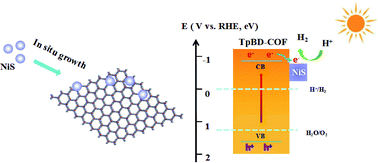Enhanced photocatalytic H2 evolution over covalent organic frameworks through an assembled NiS cocatalyst†
Abstract
Covalent organic frameworks (COFs) have been investigated in the field of photocatalysts for H2 evolution because of their crystalline structure and diversity. However, most of them need the help of noble metals as co-catalysts to realize a high hydrogen evolution. Herein, we chose typical COFs as a platform and constructed NiSX-BD (X: weight fraction of NiS) composites by assembling NiS at room temperature. The NiS nanoparticles are shown to tightly adhere to the COFs surface. Under visible light irradiation (wavelength > 420 nm), the optimized sample with 3 wt% NiS loading exhibits a photocatalytic H2 evolution rate of 38.4 μmol h−1 (3840 μmol h−1 g−1), which is about 120 folds higher than that of the pure TpBD-COF and better than TpBD-COF/Pt with the same Pt loading (3 wt%). NiS3-BD shows stable hydrogen evolution in at least six consecutive cycle tests totaling 18 h. Further investigation reveals that the loaded NiS can facilitate the transfer of photogenerated electrons from TpBD-COF to the co-catalyst, leading to efficient and high photocatalytic activity. Combining the significant feature of COFs, this study opens up a feasible avenue to boost the photocatalytic H2 performance by constructing the synergetic effects between COFs and cost-effective material.



 Please wait while we load your content...
Please wait while we load your content...